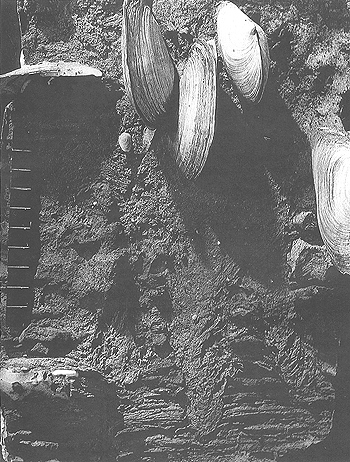
Vertical structures in shallow water: escape traces
Plate 150

Vertical structures in shallow water: escape traces
Plate 150
Bivalves, belonging to the species Mya arenaria, are here found in living position within nearshore sands of the North Sea coast. Below each shell, a vertical trace can be seen, which crosses and truncates depositional laminations. The filling sand is laminated too, but the laminae are biogenic in this case: they are concave-up and meniscus-shaped. The organism makes them by stuffing and compacting sand at the bottom of its living place. In so doing, it elevates its position. This means that the depositional surface is accreting, because each filter-feeding animal has its optimal depth of burial and tends to keep it constant. It is thus obliged to follow the ups and downs of the bottom caused by sedimentation and erosion, respectively. We know that the bottom position is not stable in the submerged part of beaches because of seasonal changes and exceptional events.
Sedimentation can be particularly rapid in the wake of a storm event; the organism trying to keep pace with it leaves an escape trace, or burrow; if it succeeds, the trace will reach the new interface, otherwise it will remain buried (blind). The meniscus-like traces, called spreiten structure, indicate the vertical movement of the animal.
| Photo: H. E. Reineck 1970. |